The global cigarette packaging material market is projected to grow from USD 12,407.3 million in 2025 to approximately USD 16,353.4 million by 2035, recording an absolute increase of USD 3,946.1 million over the forecast period. This translates into a total growth of 31.8%, with the market forecast to expand at a compound annual growth rate (CAGR) of 2.8% between 2025 and 2035. The overall market size is expected to grow by nearly 1.32X during the same period, supported by increasing cigarette consumption in emerging markets, growing demand for premium packaging solutions, and rising adoption of advanced packaging materials that enhance product protection and brand differentiation across global tobacco markets.
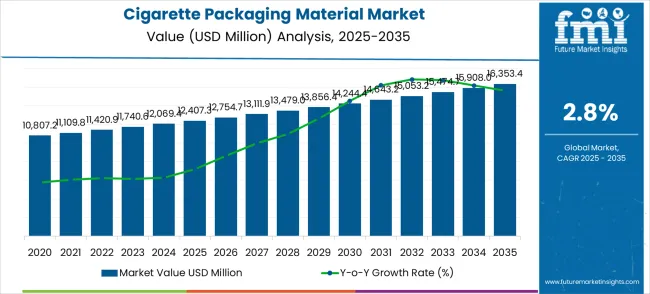
Between 2025 and 2030, the cigarette packaging material market is projected to expand from USD 12,407.3 million to USD 14,244.4 million, resulting in a value increase of USD 1,837.1 million, which represents 46.5% of the total forecast growth for the decade. This phase of growth will be shaped by increasing cigarette production in developing economies, growing demand for premium packaging solutions in established markets, and rising adoption of advanced barrier materials for product freshness preservation. Tobacco manufacturers are investing in sophisticated packaging materials to enhance brand differentiation and meet evolving regulatory requirements across diverse regional markets.
| Metric | Value |
|---|---|
| Market Value (2025) | USD 12,407.3 million |
| Market Forecast Value (2035) | USD 16,353.4 million |
| Forecast CAGR (2025-2035) | 2.8% |
The cigarette packaging material market maintains a significant share in the packaging materials market, contributing around 8% due to the growing demand for cigarette-specific packaging solutions. Within the tobacco products market, it captures about 10%, driven by the essential need for packaging materials to protect and present tobacco products. In the consumer goods packaging market, the market share is around 5%, as cigarette packaging is a part of the broader consumer goods sector. The flexible packaging market accounts for about 6%, reflecting its role in providing adaptable and cost-effective packaging solutions. In the paperboard packaging market, the cigarette packaging material market holds roughly 4%, as paperboard is commonly used for cigarette carton packaging.
Market expansion is being supported by the consistent demand for tobacco products in established and emerging markets, creating sustained need for reliable and attractive packaging solutions that protect product quality and enhance brand appeal. Modern cigarette packaging requires sophisticated materials with superior barrier properties to maintain product freshness while providing distinctive brand presentation and regulatory compliance capabilities. The essential role of packaging materials in product protection and brand differentiation makes them indispensable components in competitive tobacco markets where product quality and visual appeal are critical for consumer preference.
The growing emphasis on premium packaging and brand differentiation is driving demand for advanced packaging materials from certified suppliers with proven track records of quality and innovation. Tobacco manufacturers are increasingly investing in sophisticated packaging solutions that offer superior product protection while meeting stringent regulatory requirements and anti-counterfeiting measures. Industry regulations and quality standards are establishing performance benchmarks that favor precision-engineered packaging materials with enhanced barrier properties and comprehensive compliance features.
The tobacco industry's focus on product premiumization and market differentiation is creating substantial demand for innovative packaging materials capable of supporting luxury product positioning and enhanced consumer experience. The electronic cigarette sector continues to drive innovation in specialized packaging applications while maintaining cost-effectiveness, leading to development of advanced packaging material formulations with optimized performance characteristics and enhanced visual appeal for emerging tobacco product categories.
The market is segmented by material type, application, and region. By material type, the market is divided into paper material and film material configurations. Based on application, the market is categorized into traditional cigarettes and electronic cigarettes. Regionally, the market is divided into North America, Europe, East Asia, South Asia & Pacific, Latin America, and Middle East & Africa.
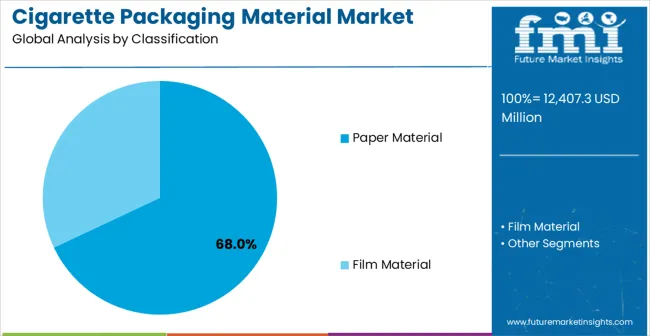
Paper material configurations are projected to account for 68% of the cigarette packaging material market in 2025. This leading share is supported by the widespread adoption in traditional cigarette packaging and established manufacturing processes utilizing paper-based packaging solutions. Paper materials provide proven cost-effectiveness and manufacturing scalability, making them the preferred choice for high-volume cigarette production, established tobacco brands, and standard packaging applications. The segment benefits from mature manufacturing technologies that have achieved excellent printability and cost optimization while maintaining product protection capabilities.
Modern paper materials incorporate advanced coating technologies and enhanced barrier treatments that maximize product freshness protection while ensuring consistent printing quality and visual appeal. These innovations have significantly improved cigarette packaging performance while reducing material costs and enhancing manufacturing efficiency for tobacco applications. The traditional cigarette industry particularly drives demand for paper solutions, as these applications require proven material reliability and cost-effective production scalability to maintain competitive pricing and market accessibility.
Additionally, the premium cigarette segment increasingly adopts specialized paper materials with enhanced surface treatments and superior printing capabilities to create distinctive packaging presentations that support brand differentiation. The growing emphasis on ecological packaging creates opportunities for environmentally responsible paper materials designed for tobacco packaging applications with enhanced recyclability characteristics.
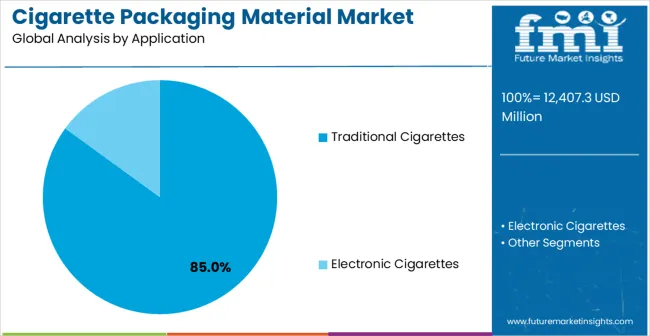
Traditional cigarettes applications are expected to represent 85% of cigarette packaging material demand in 2025. This dominant share reflects the continued global consumption of conventional tobacco products and the massive scale of traditional cigarette manufacturing worldwide. Traditional cigarette manufacturers require reliable and cost-effective packaging materials capable of providing consistent product protection while supporting high-volume manufacturing processes and regulatory compliance requirements. The segment benefits from established packaging technologies that utilize proven material solutions for comprehensive product protection and brand presentation.
The global traditional cigarette market drives significant demand for packaging-grade materials that provide exceptional barrier properties and long-term product stability for tobacco preservation and quality maintenance. These applications require packaging materials with superior moisture protection and consistent manufacturing characteristics to ensure product quality and consumer satisfaction. The segment benefits from mature supply chain relationships and increasing investment in packaging optimization for enhanced product presentation and shelf life extension.
Premium and luxury cigarette segments contribute substantially to market growth as tobacco manufacturers implement sophisticated packaging materials with enhanced visual appeal and superior product protection characteristics. The growing adoption of anti-counterfeiting features creates opportunities for specialized packaging materials designed for security applications and brand protection. Additionally, the trend toward product differentiation drives demand for distinctive packaging materials that enable unique visual presentation and enhanced brand recognition in competitive tobacco markets.
The cigarette packaging material market is advancing steadily due to consistent tobacco consumption patterns and growing recognition of packaging materials' importance in product protection and brand presentation. However, the market faces challenges including stringent tobacco regulations, increasing health awareness campaigns, and varying packaging requirement compliance across different regional markets. Regulatory standards and tobacco industry specifications continue to influence material selection and manufacturing practices.
The growing adoption of sophisticated barrier coating systems and enhanced security printing technologies is enabling significant product protection improvements while maintaining cost-effectiveness in cigarette packaging applications. Advanced material engineering and anti-counterfeiting features provide better product integrity and enhanced brand protection, enabling superior consumer confidence and reduced product tampering risks. These technologies are particularly valuable for premium tobacco applications that require maximum product protection and brand security.
Modern cigarette packaging material manufacturers are implementing comprehensive sustainability programs and regulatory compliance systems that ensure environmental responsibility while maintaining superior packaging performance and tobacco industry compliance. Advanced material formulations enable precise optimization of barrier properties and printability characteristics while supporting certification requirements for environmental standards and tobacco industry regulations.
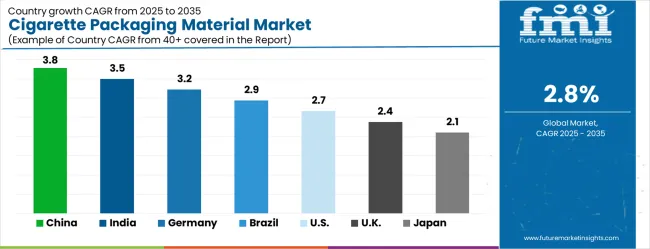
| Country | CAGR (2025-2035) |
|---|---|
| China | 3.8% |
| India | 3.5% |
| Germany | 3.2% |
| Brazil | 2.9% |
| United States | 2.7% |
| United Kingdom | 2.4% |
| Japan | 2.1% |
The cigarette packaging material market is growing moderately, with China leading at a 3.8% CAGR through 2035, driven by substantial tobacco manufacturing capacity and domestic cigarette consumption patterns. India follows at 3.5%, supported by large-scale tobacco production and growing packaging material requirements. Germany records growth at 3.2%, emphasizing packaging industry excellence and advanced material technologies. Brazil grows at 2.9%, benefiting from tobacco manufacturing expansion and regional market development. The United States shows growth at 2.7%, focusing on premium packaging solutions and regulatory compliance advancement. The United Kingdom maintains expansion at 2.4%, supported by packaging innovation development. Japan demonstrates growth at 2.1%, emphasizing quality excellence and advanced packaging technologies.
The report covers an in-depth analysis of 40+ countries, the top-performing countries are highlighted below.
The cigarette packaging material market in China is projected to exhibit the highest growth rate with a CAGR of 3.8% through 2035, driven by the country's position as the world's largest tobacco manufacturing hub and substantial domestic cigarette consumption patterns. The extensive tobacco production infrastructure and established cigarette manufacturing capabilities are creating significant opportunities for packaging material demand growth. Major tobacco manufacturers are utilizing comprehensive packaging material supply chains to support high-volume production operations while meeting domestic quality standards and export requirements.
Tobacco manufacturing leadership and domestic consumption patterns are supporting widespread adoption of cigarette packaging material technologies across commercial production operations, driving demand for cost-effective material solutions and high-volume manufacturing capabilities. Production capacity utilization and domestic market requirements are creating substantial opportunities for Chinese packaging material suppliers in domestic tobacco supply chains requiring competitive pricing and reliable material performance.
The cigarette packaging material market in India is expanding at a CAGR of 3.5%, supported by the country's large-scale tobacco production capabilities and growing cigarette packaging material requirements under domestic manufacturing expansion. The established tobacco industry infrastructure and increasing cigarette production volumes are driving substantial packaging material demand potential. Manufacturing facilities are leveraging cost advantages while adopting quality standards to meet domestic tobacco market requirements and manufacturing efficiency targets.
Tobacco production expansion and packaging material requirements are creating opportunities for cigarette packaging material integration across diverse tobacco categories requiring cost-effective packaging solutions and reliable material performance systems. Domestic tobacco market growth and manufacturing capability development are driving investments in packaging material technologies for cigarette applications throughout major tobacco production regions and manufacturing facilities.
The cigarette packaging material market in Germany is projected to grow at a CAGR of 3.2%, supported by the country's leadership in packaging industry development and advanced material technology applications. German packaging companies are implementing sophisticated cigarette packaging material systems that meet stringent quality standards and regulatory requirements. The market is characterized by focus on innovation, advanced material engineering, and compliance with comprehensive packaging quality and environmental regulations.
Packaging industry investments are prioritizing advanced cigarette packaging material technologies that demonstrate superior performance characteristics and regulatory compliance while meeting German packaging quality and environmental standards for tobacco applications. Innovation programs and packaging technology development initiatives are driving adoption of precision-engineered material systems that support optimal packaging performance and enhanced product protection capabilities.
The cigarette packaging material market in Brazil is growing at a CAGR of 2.9%, driven by tobacco manufacturing expansion and growing integration of advanced packaging materials across domestic tobacco production sectors. The growing tobacco processing infrastructure and increasing focus on packaging quality enhancement are creating opportunities for cigarette packaging material adoption. Manufacturing facilities are adopting advanced material technologies to support growing domestic tobacco consumption and export market requirements while maintaining cost competitiveness.
Tobacco manufacturing development and packaging integration expansion are facilitating adoption of effective cigarette packaging material systems capable of meeting diverse tobacco production requirements and packaging specifications across traditional cigarette applications. Regional tobacco capability enhancement and market development are creating demand for standardized packaging materials that meet tobacco industry specifications and performance requirements.
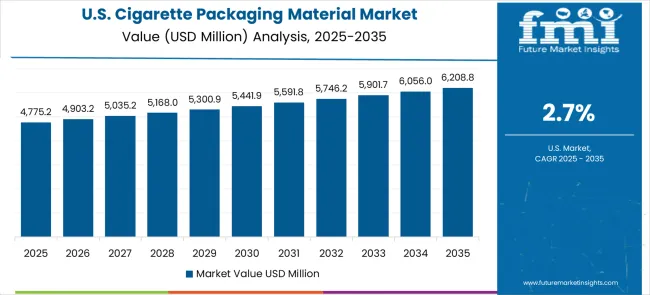
The cigarette packaging material market in the United States is expanding at a CAGR of 2.7%, driven by the country's emphasis on premium packaging solutions and increasing focus on regulatory compliance advancement in tobacco packaging applications. The sophisticated tobacco industry ecosystem and focus on packaging innovation create consistent demand for high-quality cigarette packaging material solutions. The market benefits from packaging technology advancement and regulatory requirement evolution across tobacco industry segments and compliance categories.
Premium packaging solution programs and regulatory compliance initiatives are driving adoption of advanced cigarette packaging materials that offer superior performance characteristics and compliance verification for tobacco packaging applications. Innovation investments and regulatory advancement programs are supporting demand for specialized packaging materials that meet stringent tobacco industry requirements and regulatory compliance standards.
The cigarette packaging material market in the United Kingdom is projected to grow at a CAGR of 2.4%, supported by ongoing packaging innovation development and increasing emphasis on material technology advancement in tobacco packaging applications. Packaging companies are investing in cigarette packaging material solutions that provide advanced performance characteristics and meet regulatory compliance requirements for tobacco packaging applications. The market is characterized by focus on packaging innovation, material technology advancement, and regulatory compliance across tobacco packaging applications.
Packaging innovation development and material technology programs are supporting adoption of advanced cigarette packaging material solutions that meet contemporary performance and regulatory standards for tobacco packaging applications. Innovation enhancement initiatives and packaging excellence programs are creating demand for specialized packaging materials that provide superior performance characteristics and regulatory compliance verification.
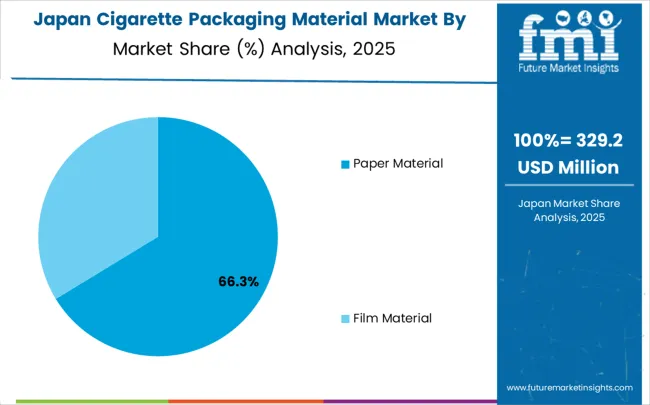
The cigarette packaging material market in Japan is expanding at a CAGR of 2.1%, driven by the country's emphasis on packaging quality excellence and advanced material technology innovation development. Japanese packaging companies are developing sophisticated cigarette packaging material applications that incorporate precision engineering and quality optimization principles. The market benefits from focus on packaging precision, material reliability, and continuous improvement in tobacco packaging performance and regulatory compliance.
Packaging quality excellence programs and technology innovation initiatives are driving advancement of premium cigarette packaging material applications that demonstrate superior performance characteristics and material reliability. Packaging technology excellence programs and quality advancement initiatives are supporting adoption of precision-engineered packaging materials that optimize tobacco packaging performance and ensure consistent quality in demanding tobacco packaging applications and regulatory environments.
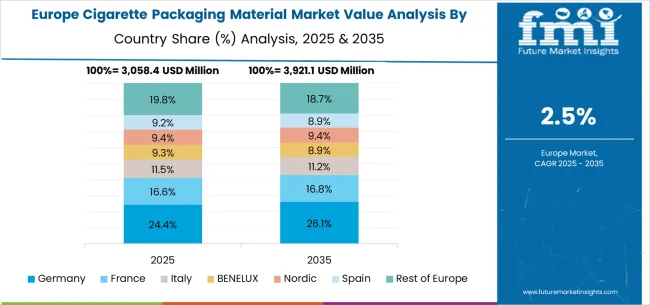
The cigarette packaging material market in Europe is projected to grow from USD 3,218.7 million in 2025 to USD 4,119.3 million by 2035, registering a CAGR of 2.5% over the forecast period. Germany is expected to maintain its leadership with a 22.1% share in 2025, supported by its advanced packaging industry and material technology excellence. The United Kingdom follows with 17.8% market share, driven by packaging innovation development and regulatory compliance advancement. France holds 15.9% of the European market, benefiting from tobacco industry presence and packaging material development. Italy and Spain collectively represent 24.6% of regional demand, with growing focus on tobacco packaging applications and material technology advancement. The Rest of Europe region accounts for 19.6% of the market, supported by tobacco industry development in Eastern European countries and packaging material advancement.
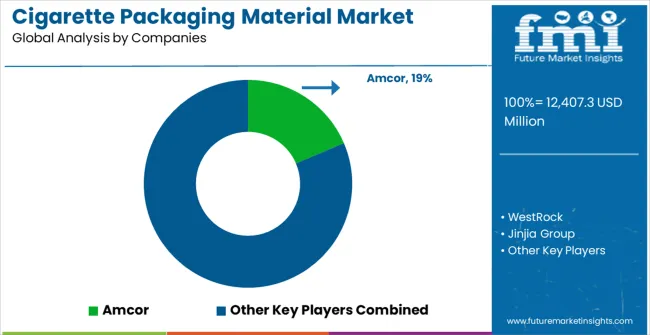
The cigarette packaging material market is defined by competition among established packaging manufacturers, specialized tobacco packaging companies, and material technology suppliers. Companies are investing in advanced material technologies, regulatory compliance systems, quality excellence programs, and manufacturing optimization capabilities to deliver reliable, compliant, and cost-effective cigarette packaging material solutions. Strategic partnerships, technological advancement, and geographic expansion are central to strengthening product portfolios and market presence.
Amcor, operating globally, offers comprehensive packaging solutions with focus on material excellence, regulatory compliance, and technical support services for tobacco packaging applications. WestRock, established packaging leader, provides advanced packaging materials with emphasis on performance optimization and manufacturing scalability for tobacco industry applications. Jinjia Group delivers specialized packaging solutions with focus on tobacco applications and cost-effectiveness. New Grand Packing offers comprehensive packaging materials with standardized procedures and tobacco industry manufacturing support.
TANN GROUP provides advanced packaging capabilities with emphasis on quality excellence and technical expertise for tobacco applications. ITC Limited delivers specialized tobacco packaging solutions with focus on domestic market requirements and manufacturing integration. Delfort offers comprehensive packaging materials with tobacco industry specialization and performance optimization. Stora Enso provides advanced packaging technologies with global manufacturing and sustainability capabilities.
Litu Holdings, Shaanxi Jinye Weili Holdings, Innovia Films (CCL), YUTO, Treofan Group, GuiZhou YongJi, Taghleef Industries Group, SIBUR, DFP, TCPL Packaging Ltd, and Egem Ambalaj offer specialized cigarette packaging material expertise, regional production capabilities, and technical support across tobacco packaging and material technology networks.
The cigarette packaging material market underpins tobacco product protection, brand presentation excellence, regulatory compliance assurance, and manufacturing efficiency optimization. With evolving tobacco regulations, packaging requirement complexity, and material performance standards, the sector faces pressure to balance product protection effectiveness, regulatory compliance consistency, and manufacturing cost-effectiveness. Coordinated contributions from governments, industry bodies, OEMs/technology integrators, suppliers, and investors will accelerate the transition toward compliant, high-performance, and cost-optimized cigarette packaging material solutions.
Technology Investment: Channel capital toward next-generation packaging materials, advanced manufacturing systems, and compliance verification technologies for improved performance and regulatory adherence.
| Item | Value |
|---|---|
| Quantitative Units | USD 12,407.3 million |
| Classification Type | Paper Material, Film Material |
| Application | Traditional Cigarettes, Electronic Cigarettes |
| Regions Covered | North America, Europe, East Asia, South Asia & Pacific, Latin America, Middle East & Africa |
| Country Covered | United States, Germany, India, China, United Kingdom, Japan, Brazil, and other 40+ countries |
| Key Companies Profiled | Amcor, WestRock, Jinjia Group, New Grand Packing, TANN GROUP, ITC Limited, Delfort, Stora Enso, Litu Holdings, Shaanxi Jinye Weili Holdings, Innovia Films (CCL), YUTO, Treofan Group, GuiZhou YongJi, Taghleef Industries Group, SIBUR, DFP, TCPL Packaging Ltd, Egem Ambalaj |
The global cigarette packaging material market is estimated to be valued at USD 12,407.3 million in 2025.
The market size for the cigarette packaging material market is projected to reach USD 16,353.4 million by 2035.
The cigarette packaging material market is expected to grow at a 2.8% CAGR between 2025 and 2035.
The key product types in cigarette packaging material market are paper material and film material.
In terms of application, traditional cigarettes segment to command 85.0% share in the cigarette packaging material market in 2025.






Our Research Products

The "Full Research Suite" delivers actionable market intel, deep dives on markets or technologies, so clients act faster, cut risk, and unlock growth.

The Leaderboard benchmarks and ranks top vendors, classifying them as Established Leaders, Leading Challengers, or Disruptors & Challengers.

Locates where complements amplify value and substitutes erode it, forecasting net impact by horizon

We deliver granular, decision-grade intel: market sizing, 5-year forecasts, pricing, adoption, usage, revenue, and operational KPIs—plus competitor tracking, regulation, and value chains—across 60 countries broadly.

Spot the shifts before they hit your P&L. We track inflection points, adoption curves, pricing moves, and ecosystem plays to show where demand is heading, why it is changing, and what to do next across high-growth markets and disruptive tech

Real-time reads of user behavior. We track shifting priorities, perceptions of today’s and next-gen services, and provider experience, then pace how fast tech moves from trial to adoption, blending buyer, consumer, and channel inputs with social signals (#WhySwitch, #UX).

Partner with our analyst team to build a custom report designed around your business priorities. From analysing market trends to assessing competitors or crafting bespoke datasets, we tailor insights to your needs.
Supplier Intelligence
Discovery & Profiling
Capacity & Footprint
Performance & Risk
Compliance & Governance
Commercial Readiness
Who Supplies Whom
Scorecards & Shortlists
Playbooks & Docs
Category Intelligence
Definition & Scope
Demand & Use Cases
Cost Drivers
Market Structure
Supply Chain Map
Trade & Policy
Operating Norms
Deliverables
Buyer Intelligence
Account Basics
Spend & Scope
Procurement Model
Vendor Requirements
Terms & Policies
Entry Strategy
Pain Points & Triggers
Outputs
Pricing Analysis
Benchmarks
Trends
Should-Cost
Indexation
Landed Cost
Commercial Terms
Deliverables
Brand Analysis
Positioning & Value Prop
Share & Presence
Customer Evidence
Go-to-Market
Digital & Reputation
Compliance & Trust
KPIs & Gaps
Outputs
Full Research Suite comprises of:
Market outlook & trends analysis
Interviews & case studies
Strategic recommendations
Vendor profiles & capabilities analysis
5-year forecasts
8 regions and 60+ country-level data splits
Market segment data splits
12 months of continuous data updates
DELIVERED AS:
PDF EXCEL ONLINE
Cigarette Butt Market Size and Share Forecast Outlook 2025 to 2035
Cigarette Filters Market Size and Share Forecast Outlook 2025 to 2035
Cigarette Making Equipment Market Size and Share Forecast Outlook 2025 to 2035
Cigarette Inner Liner Market Size and Share Forecast Outlook 2025 to 2035
Global Cigarette Paper Market Analysis – Growth & Forecast 2024-2034
Cigarette Packaging Machine Market Size and Share Forecast Outlook 2025 to 2035
Market Share Breakdown of Cigarette Packaging Machine Manufacturers
Premium Cigarette Market Growth – Demand & Industry Outlook to 2035
Smokeless Cigarettes Market Trends – Growth & Outlook 2025 to 2035
Automotive Cigarette Lighters Market
Disposable E-Cigarettes Market Size and Share Forecast Outlook 2025 to 2035
Flavor Capsule Cigarette Market Analysis - Size, Share, and Forecast 2025 to 2035
Flavor Capsule Cigarettes Market
Demand For Flavor Capsule Cigarette Products in EU Size and Share Forecast Outlook 2025 to 2035
Packaging Supply Market Size and Share Forecast Outlook 2025 to 2035
Packaging Testing Services Market Size and Share Forecast Outlook 2025 to 2035
Packaging Tubes Market Size and Share Forecast Outlook 2025 to 2035
Packaging Jar Market Forecast and Outlook 2025 to 2035
Packaging Barrier Film Market Size and Share Forecast Outlook 2025 to 2035
Packaging Films Market Size and Share Forecast Outlook 2025 to 2035

Thank you!
You will receive an email from our Business Development Manager. Please be sure to check your SPAM/JUNK folder too.
Chat With
MaRIA